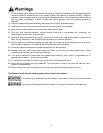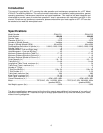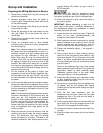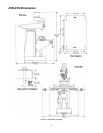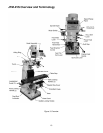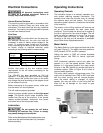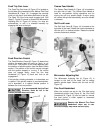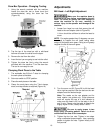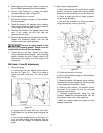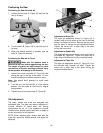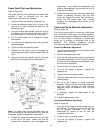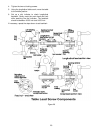
13
Spindle Brake
The spindle brake lever is located on the upper left
side of the mill head (Figure 8). Pull lever downward
to apply the brake. The spindle brake lever is used
only after the motor switch has been set to OFF. The
spindle will not stop with the motor running.
Figure 8
High-Neutral-Low Shift Lever
The mill head can be driven directly (High Speed) or
through the back gear (Low Speed) in the mill head.
The selection is made by changing the position of the
shift lever.
The shift lever is located at the lower right side of the
mill head (Figure 9). The lever position closest to the
operator is the High setting. The lever position away
from the operator is the Low setting. The middle
position is the Neutral setting.
Do not shift the High-Low Gear
Lever while the motor is
running. Rotate the spindle by hand to facilitate
changing lever positions.
Figure 9
Quill Power Feed Lever
Do not use power feed at speeds
above 3000 R.P.M.
It is recommended to disengage
the power feed worm gear
whenever the power feed is not required. This
avoids unnecessary wear on the worm gear.
Do not move the Quill Power
Feed Lever unless the motor is
at a complete stop. When changing the lever
position, do it gently. If the gear does not engage,
jog the motor and allow it to stop before
attempting to change.
The quill power feed lever is located on the right side
of the mill head (Figure 10). It is used to engage and
disengage the quill power feed mechanism.
The power feed is engaged by pulling out the knob
and rotating the handle to a new locked position.
When engaged, the power feed mechanism will drive
the spindle upward or downward. The power feed
mechanism will not drive the spindle when the handle
is in the disengage position.
Figure 10
Feed Rate Lever
The Feed Rate Lever (Figure 11) is used to set the
per-revolution rate of the power feed mechanism.
Three feed rates are available: 0.0015-inch, 0.003-
inch, and 0.006-inch per revolution. The positions are
shown on an indicator plate under the feed rate lever.
The rate is selected by pulling out the knob on the
feed rate lever and moving the handle to the detent of
the desired feed rate.
Note: The knob is spring loaded – pull out to rotate to
new position.
Unlike other controls on the machine, the lever shifts
into engagement more easily with the motor running,
and the quill feed lever engaged.
Figure 11



